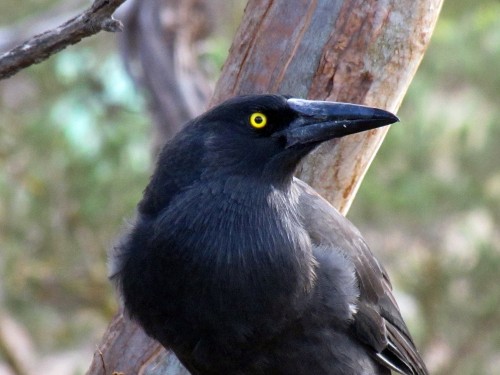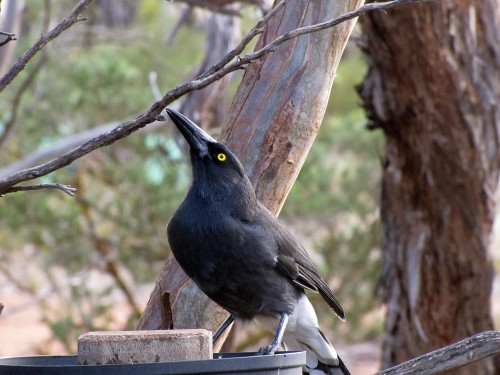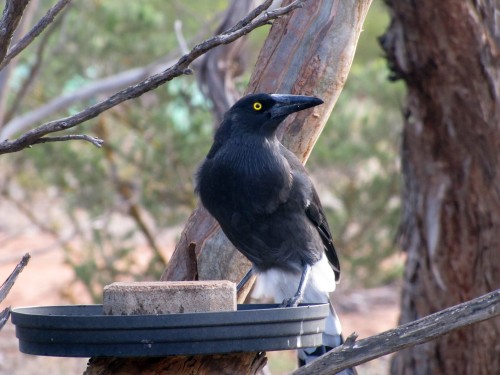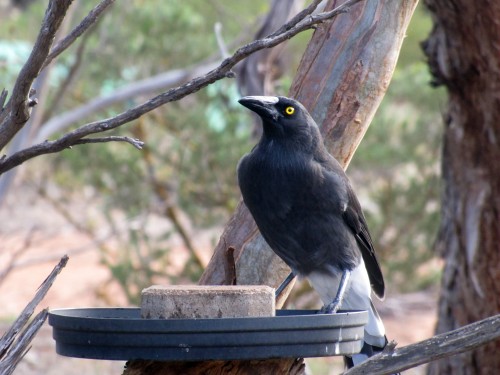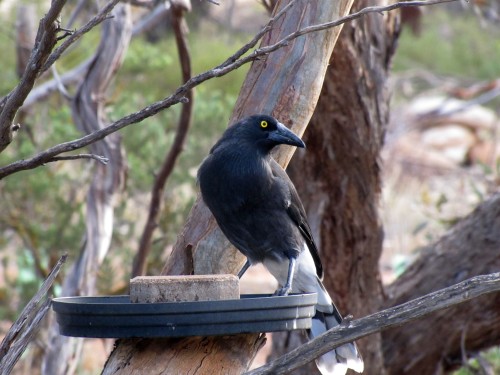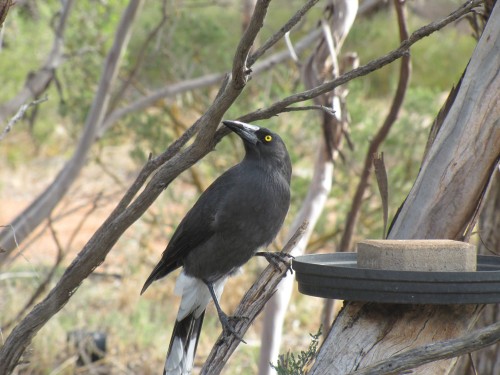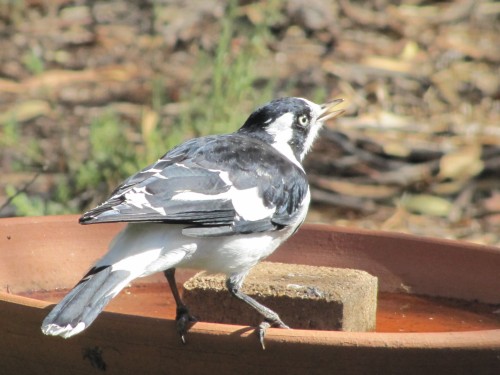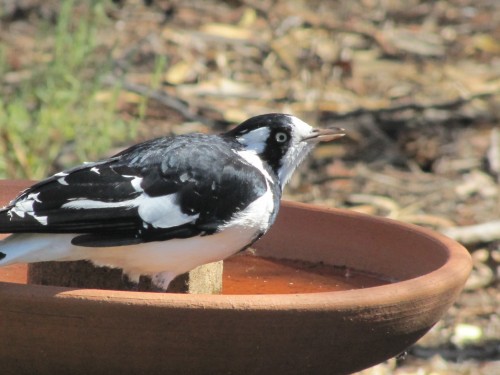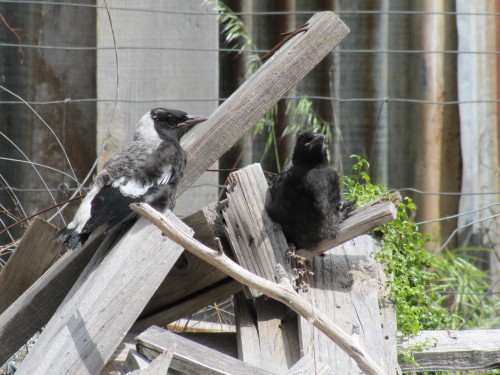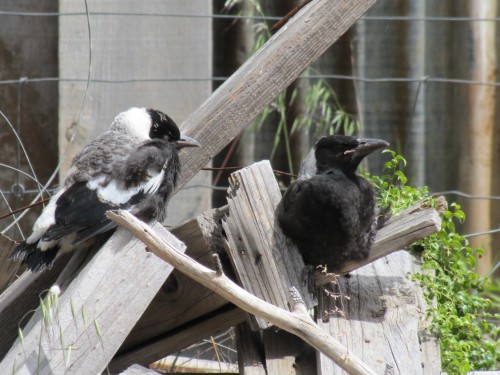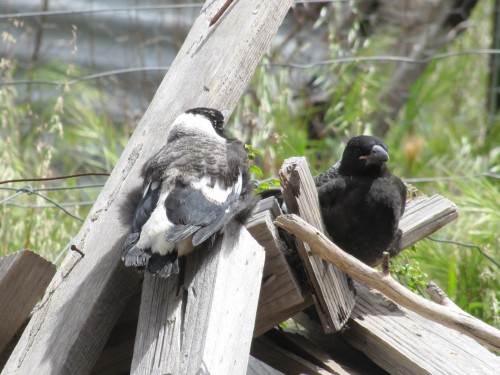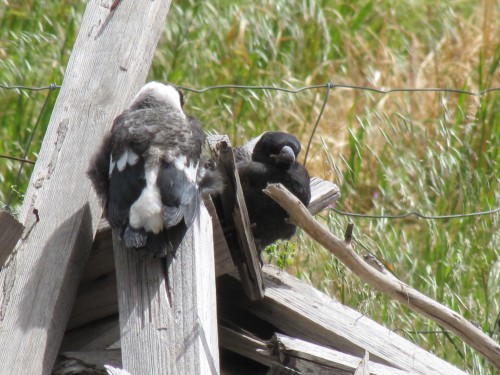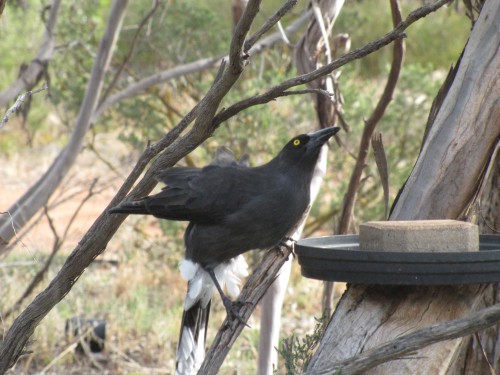Giving an evil eye?
When we bought our home some 30 years ago we never heard or saw Grey Currawongs in our garden or anywhere on our five acre block. They are moderately common and widespread in the district, and this is also true throughout their normal range in southern Australia so it was surprising that we never saw this species in the first decade we lived here.
It appears that several birds moved into the mallee scrub area up the road about a kilometre on a hill overlooking our property. When they called – something which happened only occasionally – we were aware of their presence.
About ten years ago several individuals would occasionally either fly over head, or settle briefly in one of our trees before moving on. This happened every month or so. About five years ago a pair started frequently following their offspring onto our property. These visits occurred every few days.
Now they are relatively regular visitors, even coming to our bird bath on hot days. When they do this it gives me a great opportunity to take a series of photos, like those shown today. These were taken last week during our most recent heat wave.
When you have close up views of this species you suddenly realise how big they are, compared with most of the birds which visit the bird baths. They are much larger than the Australian Magpie-larks, a little larger than Australian Magpies and even the Little Raven. They are certainly much larger than the many honeyeaters which come to drink, and the dainty pardalotes, thornbills and silvereyes are positively minuscule in comparison.
And how about that glaring eye?
Positively gives me a creepy feeling.
A sudden awakening
A few mornings ago I was just emerging from a good night’s sleep when there was a very loud bang on our bedroom window. Light was just beginning to filter into the room past the edges of our curtains. After this sudden noise there was no hope of dreaming on – or of sleeping in for a while.
In my bare feet I padded across to the window and drew the curtains, expecting to see a half-dazed bird on the pavers of the path outside.
Nothing. After showering and dressing I went into the garden to investigate. Still nothing. But the bird which had crashed into our window had left two nasty after-effects.
Streaked across the glass was a huge mess where the bird had defecated on impact.
And the glass pane was neatly cracked – diagonally from one top corner to the opposite bottom corner.
We frequently have birds crash into our windows; it probably happens every few weeks. Usually they are just stunned for a few minutes before they fly off, wiser perhaps for the experience. Several times a year – perhaps only once or twice – a bird will be so badly hurt that it is killed on impact. Usually it is the smaller birds such as the pardalotes.
Collisions like this happen all over the world. The birds see a reflection of some trees or a park or a garden in the window and they assume that they can fly right on through – until they come to a sudden halt when they hit the glass. There is very little one can do to prevent this unfortunately.
On this occasion, however, there remained a puzzle. Which species had caused such a devastating impact on our window – enough to crack it so thoroughly? My first thought was a baby magpie just learning to fly. We have several of them around at present. Then I thought it could have been a Little Raven. Tough critters – but we haven’t seen many of those around recently.
This morning I realised that it could have been a Grey Currawong. Several have been hanging around the garden recently and with their enormous beak the impact could have been caused by one of them.
Unless they start talking to me, I guess I’ll never know!
Photographic study of an Australian Magpie Lark
Sometimes I am lucky and get just the right pose in the birds I am photographing.
And sometimes they don’t cooperate.
Or the light is wrong.
Or it’s not in focus.
Or part of the bird is accidentally cropped – like the tail in the shot below.
Oh, well – you don’t get it right every time. I’ll just keep trying.
Maybe next time…
Wild weather and baby magpies
Over the last few weeks we have had some violent wind storms. Spring here in South Australia can often be windy, but these were gale force winds. One afternoon earlier this week wind gusts up to 80kph were recorded many times. While we didn’t suffer any property damage others in our state were not as fortunate. One poor man even drowned when his boat was overturned in rough conditions on the River Murray upstream from my home town of Murray Bridge.
During the worst of the stormy weather I was concerned for the baby magpies in two nests within 50 metres of my office where I am writing this post. We had watched with interest when the nests were being built. Actually, they were last year’s nests which were refurbished. Then we waited while the mother birds sat patiently during the incubation period. Then over the last few weeks there was a constant begging noise from the babies.
When the first storm hit last Monday the babies were able to hang on to the nesting material. The following storms on Wednesday were even worse and the young were blown out of their cosy homes. Watching them today I suspect that they were not yet quite ready to fledge* because they are still unable to fly; they run everywhere – well, it’s more of a wobbly, unsteady waddle.
At one point the two babies from the nest closest to our house clambered up on a heap of scrap wood near the garage. I managed to get up reasonably close without spooking them, thus getting some good photos. You will notice that they are still very downy. These downy feathers will remain for some months yet. You will also notice that the nearest one has not much of a tail yet. In the first few days after fledging, they are terrible flyers as they learn how to get around; having virtually no tail does not help.
*Note: to see a definition of the word fledge click here.
Further reading:
- Baby Magpie – the most popular post on this site with nearly 500 comments from readers.
- Crash landing for a baby magpie
Grey Currawong at the bird bath
When moved to our current home and five acre block nearly 30 years ago. Over that time I have recorded over a hundred different species that have visited or flown over. About 40 of those are resident – meaning they can be seen most days – and most of those have been recorded breeding here.
The locally common Grey Currawong was a notable species absent from my lists for several decades. We would occasionally hear one calling in the distance up the hill about a kilometre away. This is an area of thick mallee scrub. They rarely ventured down into our garden.
That all changed about ten years ago. Now this species is a frequent visitor in our garden and we see or hear one or more every few days. I still wouldn’t call it a resident species, though. On a few occasions a local breeding pair have brought their recently fledged off-spring to visit too.
Even rarer is a visit to one of our bird baths, but this, too, is changing. Last week I managed a few good photos of one bird as it was drinking. Those bright yellow eyes are quite penetrating, and I am not surprised that smaller birds – like the thornbills and honeyeaters – get very nervous when the currawongs are around, sending out warning calls. That large beak would easily gobble down a nestling by the look of it.
